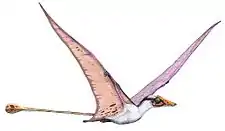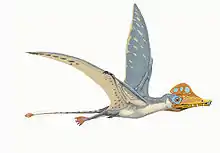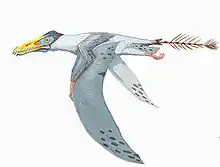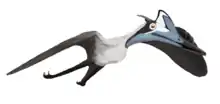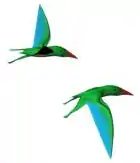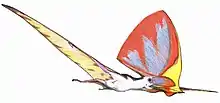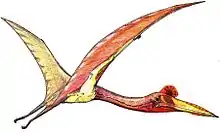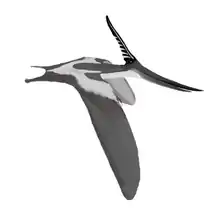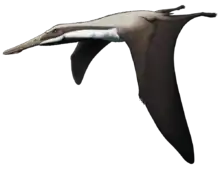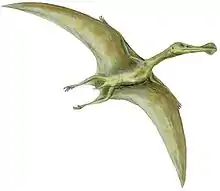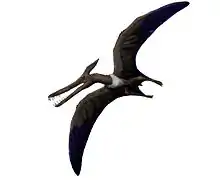Alanqa
Alanqa is a genus of pterodactyloid pterosaur from the Late Cretaceous period (Cenomanian stage) of what is now the Kem Kem Beds of southeastern Morocco. The name Alanqa comes from the Arabic word العنقاء al-‘Anqā’, for a mythical bird of Arabian culture.[1]
| Alanqa | |
|---|---|
 | |
| Jaws (top left) compared to the skull of Zhejiangopterus (top right) and the lower jaw of Quetzalcoatlus (bottom) | |
| Scientific classification | |
| Kingdom: | Animalia |
| Phylum: | Chordata |
| Order: | †Pterosauria |
| Suborder: | †Pterodactyloidea |
| Family: | †Azhdarchidae |
| Genus: | †Alanqa Ibrahim et al., 2010 |
| Species: | †A. saharica |
| Binomial name | |
| †Alanqa saharica Ibrahim et al., 2010 | |
Discovery
Aided by local villagers, a team of paleontologists had been excavating at several locations in the Kem Kem Beds during April, and November to December 2008, uncovering remains of several different pterosaurs. The material was fragmentary, and the type locality for Alanqa is Aferdou N'Chaft, near the village of Begaa and 10 kilometers (6.2 mi) to the north-east of Taouz.[1]
Description
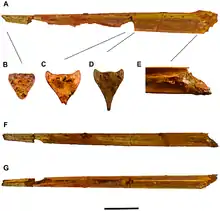
Alanqa is known only from five fragments of the front upper and lower jaws, and possibly a neck vertebra, representing the single type species Alanqa saharica.[1] Two of these fragments were first described, but not named, by Wellnhofer and Buffetaut in 1999, and referred to a pteranodontid.[2] Three additional jaw specimens, including a better preserved upper jaw, were described and named by Ibrahim and colleagues in 2010.[1] The jaws were straight and pointed, like those of the azhdarchids Quetzalcoatlus and Zhejiangopterus. Based on comparison to related species, the Alanqa saharica the individuals known from jaw specimens probably had wingspans of about 4 meters (13 ft). However, according to Ibrahim and colleagues, the vertebra (which probably belonged to the same species) appeared to come from a larger individual, measuring about 6 meters (20 ft) in wingspan.[1]
A rostrum fragment was described in 2015 and referred to cf. Alanqa based on provenance. This fragment has two bony protuberances where the jaw occludes, coinciding with an eminence on one of the mandibles originally referred to Alanqa. These imply an unusual functional specialization in this pterosaur; possible functions include visual display, anchoring of soft tissue, and crushing hard-shelled food.[3]
Classification
In its initial description, Alanqa was referred to the Azhdarchidae, based on the similarity of its jaws to those of Quetzalcoatlus and Zhejiangopterus.[1] This result was reproduced by a subsequent analysis.[4] However, another analysis recovered it as a thalassodromid, close to Aerotitan (previously also considered an azhdarchid).[5]
Paleoecology
Alanqa was recovered from the Kem Kem Group of the late Cenomanian period, then a freshwater delta system. It is believed to have been in the middle of ecosystem's food web, preying on both small animals like crustaceans and mollusks,[3] amphibians like Kababisha and Oumtkoutia, small to medium-sized reptiles like Simoliophis libycus and Jeddaherdan aleadonta, and even small or juvenile dinosaurs, much like other azhdarchids. On the other hand, Alanqa would be a prey item for the large predators of the ecosystem, such as theropod dinosaurs, (Spinosaurus, Carcharodontosaurus, and Sauroniops), and reptiles like Aegisuchus, and an unidentified Madtsoiid snake.
References
- Ibrahim, Nizar; Unwin, David M; Martill, David M; Baidder, Lahssen; Zouhri, Samir (2010). "A New Pterosaur (Pterodactyloidea: Azhdarchidae) from the Upper Cretaceous of Morocco". PLOS ONE. 5 (5): e10875. Bibcode:2010PLoSO...510875I. doi:10.1371/journal.pone.0010875. PMC 2877115. PMID 20520782.
- Wellnhofer, Peter; Buffetaut, Eric (1999). "Pterosaur remains from the Cretaceous of Morocco". Paläontologische Zeitschrift. 73 (1–2): 133–142. doi:10.1007/BF02987987. S2CID 129032233.
- Martill, David M; Ibrahim, Nizar (2015). "An unusual modification of the jaws in cf. Alanqa, a mid-Cretaceous azhdarchid pterosaur from the Kem Kem beds of Morocco". Cretaceous Research. 53: 59–67. doi:10.1016/j.cretres.2014.11.001.
- Vullo, Romain; Garcia, Géraldine; Pascal, Godefroit; Cincotta, Aude; Valentin, Xavier (2018). "Mistralazhdarcho maggii, gen. et sp. nov., a new azhdarchid pterosaur from the Upper Cretaceous of southeastern France". Journal of Vertebrate Paleontology. 38 (4): (1)-(16). doi:10.1080/02724634.2018.1502670. S2CID 91265861.
- Longrich, Nicholas R; Martill, David M; Andres, Brian (2018). "Late Maastrichtian pterosaurs from North Africa and mass extinction of Pterosauria at the Cretaceous-Paleogene boundary". PLOS Biology. 16 (3): e2001663. doi:10.1371/journal.pbio.2001663. PMC 5849296. PMID 29534059.
